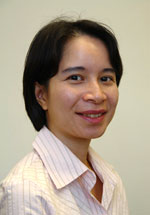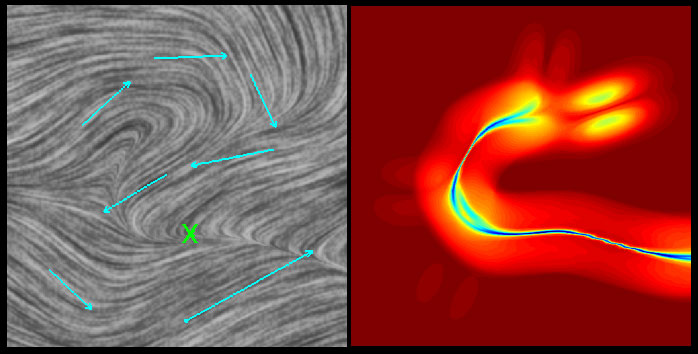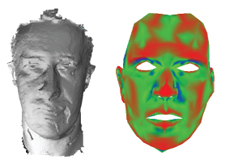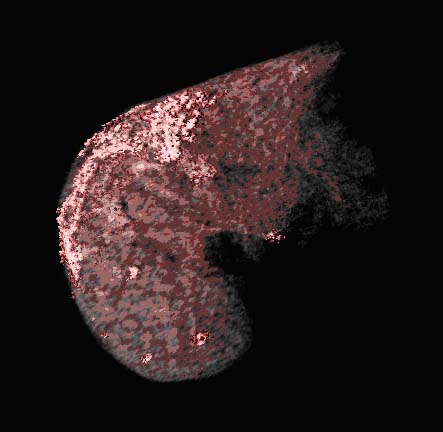
q (at) hqdinh.com
CV . Publications . Grants
My research is in the areas of computer vision and graphics, with emphasis on shape reconstruction from point clouds, shape transformation, and geometric pattern matching. I also develop algorithms for shape and vector field pattern matching. The following summarizes my research projects.


To record local statistics, we adapt the spin-image representation for surface points to vector fields (shape contexts and other data structures can be similarly adapted). Local distributions are used to track points through vector fields with the ultimate goal of identifying the source of turbulent flow, a problem important to automotive and ocean engineers. In automotive engine design, a turbulent-free flow through the combustion chamber leads to optimal mixing of fuel and air and a more efficient combustion process.
Publications:
- L. Xu, H.Q. Dinh, E. Zhang, Z. Lin, and R.S. Laramee. "A Distribution-Based Approach to Tracking Points in Velocity Vector Fields", IEEE Conf. on Computer Vision and Pattern Recognition (CVPR), 2009. PDF 538KB
- L. Xu and H.Q. Dinh. "A Local Descriptor for Finding Corresponding Points in Vector Fields", IAPR International Conference on Pattern Recognition (ICPR), Dec. 2008 PDF 1.4MB
- H.Q. Dinh and L. Xu. "Measuring the Similarity of Vector Fields Using Global Distributions", IAPR International Workshop on Structural and Syntactic Pattern Recognition (SSPR) in conjunction with ICPR, Dec. 2008 PDF 3.8MB
Sponsor:
- H.Q. Dinh. "Detecting Patterns in Vector Fields", Honda Initiation Grant, Honda Research Institute, 2009-2010.
Analogical Search

Publications:
- V. Petite , H.Q. Dinh, and E. Fisher. "A User Study on Perceiving Analogies in Images", International Digital Media and Arts Association (iDMAa) Conference, 2008. PDF 177KB
- H.Q. Dinh and S. Kropac. "Multi-Resolution Spin-Images", Computer Vision and Pattern Recognition (CVPR), June 2006 PDF 1.3MB
Sponsor:
- H.Q. Dinh and E. Fisher. "A Transderivational Search Engine for Creative Analogy Generation in Mixed-Media Design", National Science Foundation Creative IT Program, Award# IIS-0742440, 2007-2009.
Modeling Implicit Surfaces Composed of Radial Basis Functions

Extensions to this work include evolving RBF parameters for segmenting images, interactive rendering and modeling of implicit surfaces on the GPU, and frequency-domain filtering and X-ray visualization of irregularly sampled volumes on the GPU. Filtering and zooming directly in frequency space leads to more accurate and efficient signal processing. By using anisotropic RBFs fitted to data through optimization techniques, we allow the inclusion of advanced data-sensitive constraints for feature preservation.
Publications:
- H.Q. Dinh, N. Neophytou, and K. Mueller. “Continuous FVR of Irregularly Sampled Data Using Gaussian RBFs”, poster at the IEEE Visualization Conference, 2009. PDF 477KB (extended version PDF 1.1MB)
- G. Slabaugh, H.Q. Dinh, and G. Unal. "A Variational Approach to the Evolution of Radial Basis Functions for Image Segmentation", Computer Vision and Pattern Recognition (CVPR), June 2007 PDF 419KB
- A. Corrigan and H.Q. Dinh. "Computing and Rendering Implicit Surfaces Composed of Radial Basis Functions on the GPU", locally published at the International Workshop on Volume Graphics, June 2005 PDF 548KB
- H.Q. Dinh, G. Turk, and G. Slabaugh. "Reconstructing Surfaces by Volumetric Regularization Using Radial Basis Functions", IEEE Transactions on Pattern Analysis and Machine Intelligence, October 2002 PDF 2.9MB
- H.Q. Dinh, G. Turk, and G. Slabaugh. "Reconstructing Surfaces Using Anisotropic Basis Functions", International Conference on Computer Vision (ICCV), 2001 PDF 1.3MB
Sponsor:
- H.Q. Dinh, G. Turk, G. Slabaugh, and R. Schafer. "Automated Construction of Digital Models from Real Artifacts", GVU Seed Grant, 2000
Implicit Shape Transformation (Morphing)


The observation of the evolution of a course of treatment can provide a powerful tool in understanding its efficacy. To visualize this, we produce animations allowing the visualization, as a function of time, of lesions in an organ. The animation produced is a morph describing how a source shape (pre-treatment) gradually deforms into a target shape (post-treatment). The morph is computed on the GPU, so both visualization of the volumes and morph generation are performed in real-time.
Publications:
- H.Q. Dinh, A. Yezzi, and G. Turk. "Texture Transfer During Shape Transformation", ACM Transactions on Graphics (TOG), Vol.24(2), April 2005 PDF 9.78MB
- B. M. Carvalho and H.Q. Dinh. "Visualization of Treatment Evolution Using Hardware-Accelerated Morphs", 13th Conf. on Medicine Meets Virtual Reality (MMVR), Jan. 2005 PDF 183KB
- Edgardo Molina. "Panorama Generation for Stereoscopic Visualization of Large-scale Scenes", CUNY Graduate Center, 2015 (PhD committee member)
- Hadi Fadaifard. "Multiscale Feature Extraction and Matching with Applications to 3D Face Recognition and 2D Shape Warping", CUNY Graduate Center, 2011 (PhD committee member)
- Lucy Xu. "Detecting Patterns in Vector Fields", 2006 - 2009 (PhD adviser)
- Steven Kropac. "Comparing Vector Fields Using Topology Analysis", 2005 - 2009 (PhD adviser)
- Hongzhi Wang. "Computational Methods for Perceptual Organization and Recognition", Stevens Institute of Technology, 2008 (PhD committee member)
- Haitao Zhang. "Point-based Modeling for Effective Rendering", SUNY Stony Brook, 2007 (PhD committee member)
- Neophytos Neophytou, "A Generalized Framework for Interactive Volumetric Point-Based Rendering", SUNY Stony Brook, 2006 (PhD committee member)
- CS 437 - Intro to Computer Graphics
- CS 537 - Intro to Computer Graphics (graduate level)
- CS 638 - Advance Computer Graphics (graduate level)
- CS 492 - Intro to Operating Systems
- CS 520 - Intro to Operating Systems for (graduate level)